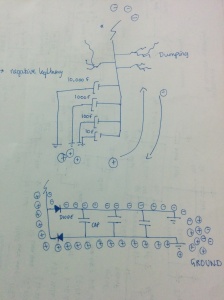We’ve all seen one, certainly. It can be scary but it packs a whole lot of power, enough power to light up your city. Storing all that isn’t theoretically possible. Lightning strikes are of two types – Negative and positive. Negative lightning strikes are the most common type where the cloud has a negative charge buildup and the ground is positive. The resulting ionization is observed as a flash of light, caused by super-heated gases (plasma). During negative lightning, the negative charges move down and the positive charges from the ground move up creating a channel for a lightning strike. I came up with a solution which I haven’t researched much on so I need your help. My design comprises mainly of a lightning conductor and capacitors.
The metal lightning conductor has outward projections for shedding off some degree of lightning voltage to ground. A fraction of the negative lightning enters the system. A large enough dielectric material is preferred with excellent relative electric permittivity i.e. permittivity of material over that in vacuum or absence of material. Capacitors consisting of largely spread metal contacts with the dielectric layer sandwiched. Separation distance when less increases capacitance. Every capacitor has it’s own channel to form the easiest and fastest path for the charges. The electric field from the strike polarizes the molecules with the negative charges moving away and positive charges facing the side where the field is applied. The result of this dielectric polarization is a charged capacitor. In my configuration, dielectric capacities (sizes) gradually decrease as the charge in the first capacitor is higher that the ones that follow. The other ends of the capacitors are individually grounded. Since the capacitor banks are responsible for soaking up the entire strike, we should make sure that only a fraction of the voltage enters the system. Each channel of capacitors should contain several thousands of them connected in parallel. A parallel config would ensure same potential across every capacitor in the system. But I wonder if the polarities of the capacitor reverse when the positive stream from the ground channel up into the sky. But given that these strikes last for a very small fraction of a second, I’m starting to wonder if a dipole moment exists while the positive stream from the ground is rising whilst the negative stream from the sky is soaked up by the ground. I’m also looking at using a diode to let the charges flow in one direction only. First to ground; Then from ground to the atmosphere like a dual-channel system. I doubt if these ‘out-of-the world’ conceptions would indeed work !
I found this resources online:
http://hyperphysics.phy-astr.gsu.edu/hbase/electric/capchg.html (you can input the time constant and solve for charging current and time to charge)
http://hyperphysics.phy-astr.gsu.edu/hbase/electric/pplate.html (calculating capacitance for a parallel plate capacitor)
I could go on and plug in assumed parameters and solve for capacitance but I can’t be sure if it is actually feasible to make one in real life.

Retrieval of the stored energy could be done using a sustained battery charger. The idea here is to slowly drain the capacitors into a battery for later use.
BEWARE: This is a conceptual idea.
